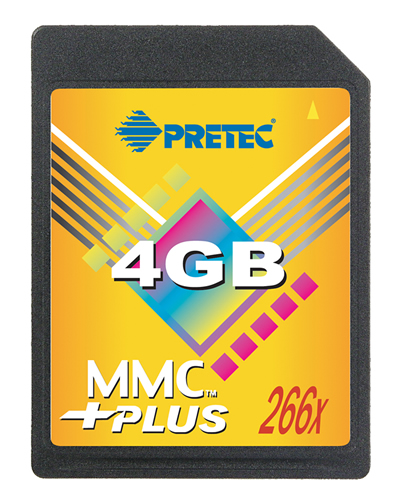 To expand the memory space available on the device, you can install a flash-based MMC card. The size of an MMC card can vary from 32 MB to 2 GBdepending on your encoding settings, 512 MB and larger cards should be sufficient for hours of movies or digital music. Most Nokia phones, such as the Nokia 6230, 3650, 6600, and 6620 smartphone, support the standard MMC cards you can buy from any electronics store. Newer Nokia phones, such as the Nokia 6630, 6670, 6681, and 6682 phones, support only a Nokia proprietary MMC format known as Dual Volt Reduced Size MMC (DV-RSMMC). The DV-RSMMC card is slightly smaller than the regular MMC card, but the former is more difficult to find and is more expensive. You should read your owner's manual or the phone specification on Nokia web sites to find out exactly what MMC card format your phone supports.
To expand the memory space available on the device, you can install a flash-based MMC card. The size of an MMC card can vary from 32 MB to 2 GBdepending on your encoding settings, 512 MB and larger cards should be sufficient for hours of movies or digital music. Most Nokia phones, such as the Nokia 6230, 3650, 6600, and 6620 smartphone, support the standard MMC cards you can buy from any electronics store. Newer Nokia phones, such as the Nokia 6630, 6670, 6681, and 6682 phones, support only a Nokia proprietary MMC format known as Dual Volt Reduced Size MMC (DV-RSMMC). The DV-RSMMC card is slightly smaller than the regular MMC card, but the former is more difficult to find and is more expensive. You should read your owner's manual or the phone specification on Nokia web sites to find out exactly what MMC card format your phone supports.To install the MMC card, you can just insert it into a socket underneath the phone battery. For some devices, such as the N-Gage QD, the MMC card socket is located in an external card slot for easy access. Refer to your phone manual for the exact installation steps. Once the MMC card is installed, you can inspect its properties via the Extras Memory menu on a Series 60 device or the Gallery Memory card Options Details menu on a Series 40 device.
On a Series 40 device, you can view the status for both the phone's main memory and the MMC card via the Settings Phone settings Memory status menu.
Installing the memory card is the first step. To use the card, you should configure applications to store data on it. In the following list, I provide instructions for installing some key applications on a Series 60 device. Series 40 devices work similarly.
Gallery
The Gallery application now displays folders in both the phone main memory and the memory card. You can move files between the two storage units.
Application installers
When you install Java or Symbian applications, the installer asks you whether to put the application on the memory card. Please note that applications installed on a memory card still leave a small stub in the main memory. Also, the applications will stop working if the memory card is removed.
Camera, video recorder, and audio recorder
In the Settings menu of the Camera, Video Recorder, and Audio Recorder applications, you can choose "Memory in use," located between "Phone memory" and "Memory card." The captured media files are automatically saved to the appropriate folders in the selected storage unit.
Messages
In the Messaging application's Settings Other menu, you can choose "Memory in use" for saved messages. If you choose "Memory card" here, the phone saves all received SMS, MMS, email, and Bluetooth messages to the memory card. This feature is available only on Series 60 devices.
The memory card is a little slower than the built-in phone memory. The memory card stores persistent information. It does not store the dynamic data generated by applications at runtime.
If you use Bluetooth to send any file larger than 4 MB to the phone (this limit is lower on some older phones), you have to set the Messaging application's memory in use to "Memory card." If you do not do that, the message-receiving operation will be aborted by a "Memory full" error because the phone's main memory is only a couple of MB in size and cannot hold the received file.





No comments:
Post a Comment